This page answers the questions most often asked by friends and visitors alike.
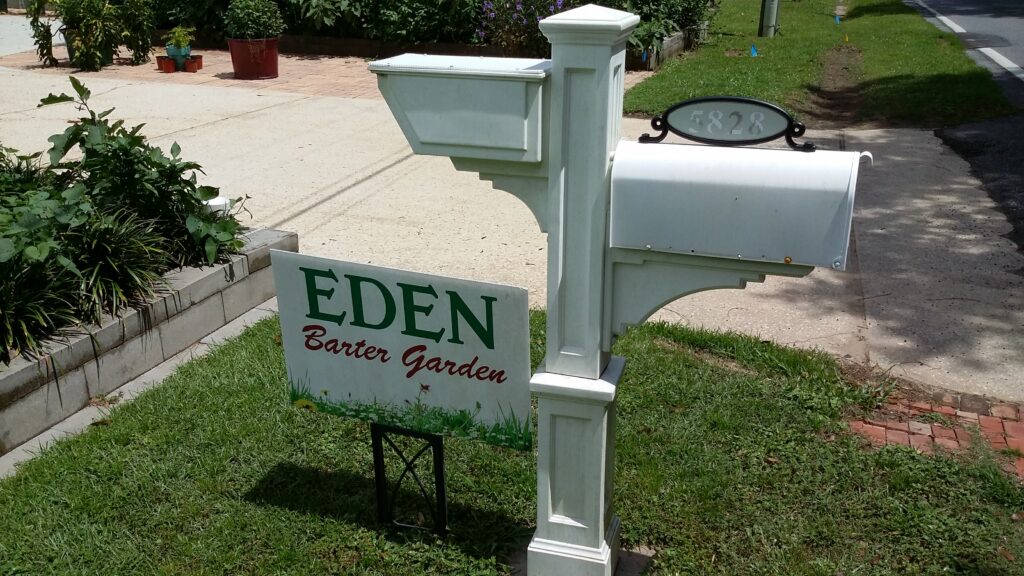
Q: Why Florida?
Florida has sustainable groundwater, plenty of sun, and a long growing season. These three assets make Florida ideal for sustainable living. In India, 32 farmers commit suicide each day because their farms have failed; a major cause of failure is depleted groundwater (see Pumped Dry: The Global Crisis of Vanishing Groundwater). If we don’t find a solution soon, depleted groundwater could destroy the large-scale corporate farms that produce the majority of our food. What will we do then? EDEN Barter Garden is working to develop solutions that help us to transition from where we are now to where we need to be in the next decade.
Q: Can I produce income from my garden?
Yes, In Florida, small-scale produce growers can sell their raw fruits and vegetables to consumers without a permit or business license. In addition, the Cottage Food Law of Florida allows you to sell certain “cottage foods” within the State of Florida.
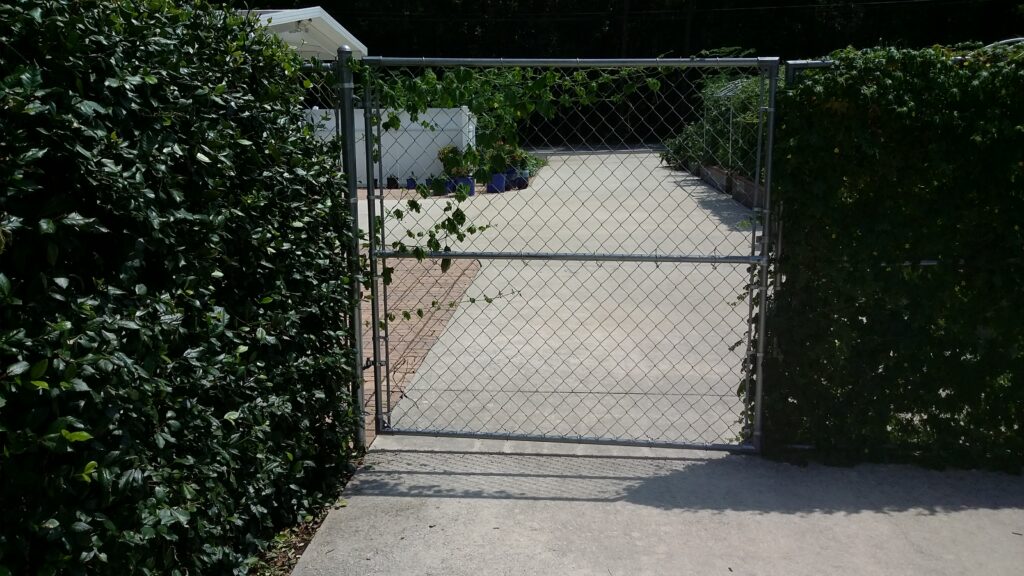
Leveraging Self-Sufficiency
Traditionally, the American dream was based on investing in a house and residential lot. Due to changing demographics, lifestyles, job markets, climate change, technology, and more, this paradigm is changing fast. Non-performing temples of conspicuous consumption are becoming obsolete; houses are becoming too expensive to purchase and maintain, and they don’t meet our future needs. The solution is to return to a family farming mentality—as best we can. The trick is to make a residential property perform. EBG does it with hard assets (gardens, solar, rainwater collection), soft assets (hybrid designs, education, exercise), and more. Dozens of visitors each year relate a common ambition—to become as self-sufficient as possible to insulate ourselves and our families from the realities of a changing world.
Read more about EBG’s Raised Garden Beds (including the Bottom Line).
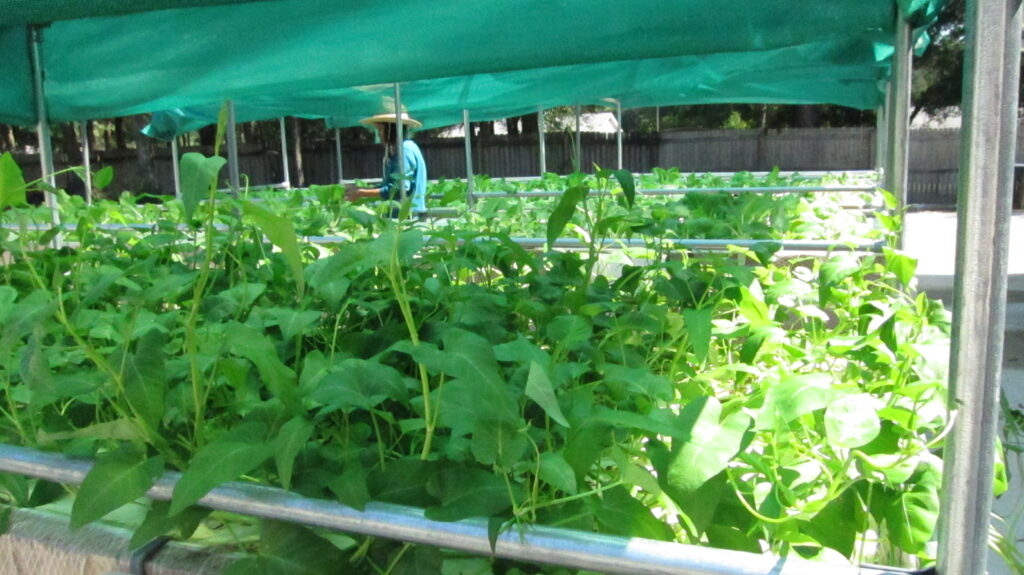
.
.
Read more about EBG’s Hydroponic Tanks (including the Bottom Line).
.
.
.
.
Q: Can a family garden satisfy our food security needs?
Yes, but not in the manner you might expect. Our most valuable crop is education; we’ve learned what it really takes to survive, not only with a garden, but with the supporting infrastructure as well. The second most valuable crop is community; a family garden can’t meet all of your food needs, but a barter community can, because we’re all working together.
Our garden insulates us from needing to run to the store every few days. Best of all, we know the quality of the food we’re eating, because we grow it ourselves. From a quantity perspective, we’ve adopted a simple strategy to insure that we always have something nutritious to eat: we planted large plots of purple sweet potatoes. Easy to grow, harvest and cook, these highly nutritious potatoes can be harvested year-round. And we grow a wide variety of other easy edibles. The hardest part of gardening (aside from the labor) is fighting the bugs!
Q: Is solar worth the investment?
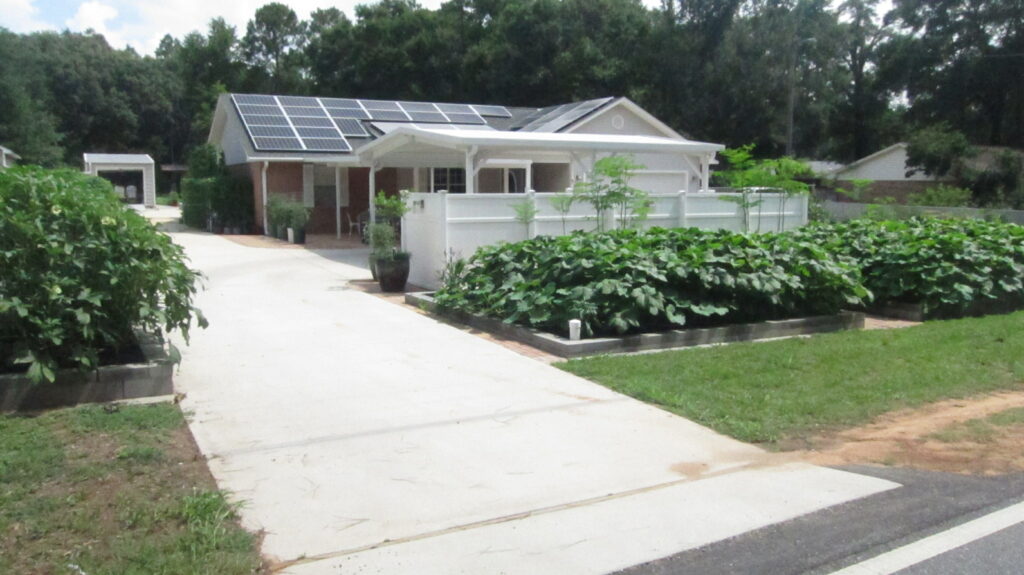
Yes. (1) Solar hot water systems are the best-kept secret in the solar realm, especially in sunny states like Florida. The net cost of a solar hot water system is about $3500. It provides 80-gallons of hot water (up to 150-degrees) daily, for ten months of the year (greatly reducing your overall electricity needs). (2) Our Tier-2 PV (photo voltaic) system earns 1 carbon credit per day. Currently, residential carbon credits are not very valuable (ranging from $5-13), but that’s expected to change with the advancing green agenda. At some point, we expect to be able to trade our accumulating carbon credits on an open market. (3) Solar panels are warranted for 25 years, but although they degrade, their actual lifespan is indefinite. (4) Federal tax credits are going away (dropping to 26% in 2020). Get ’em while you can! (5) Dependable electrical service is not guaranteed (look at California and Texas). (6) Residential properties with solar sell faster than comparable properties without solar. (7) When leveraged with the other self-sufficient features of EBG, solar hot water and solar power work synergistically to enhance the overall value (from a sustainability perspective) of the project.
Read more about EBG’s Solar PV / Hot Water (including the Bottom Line).
Q: What’s the best design for raised beds?
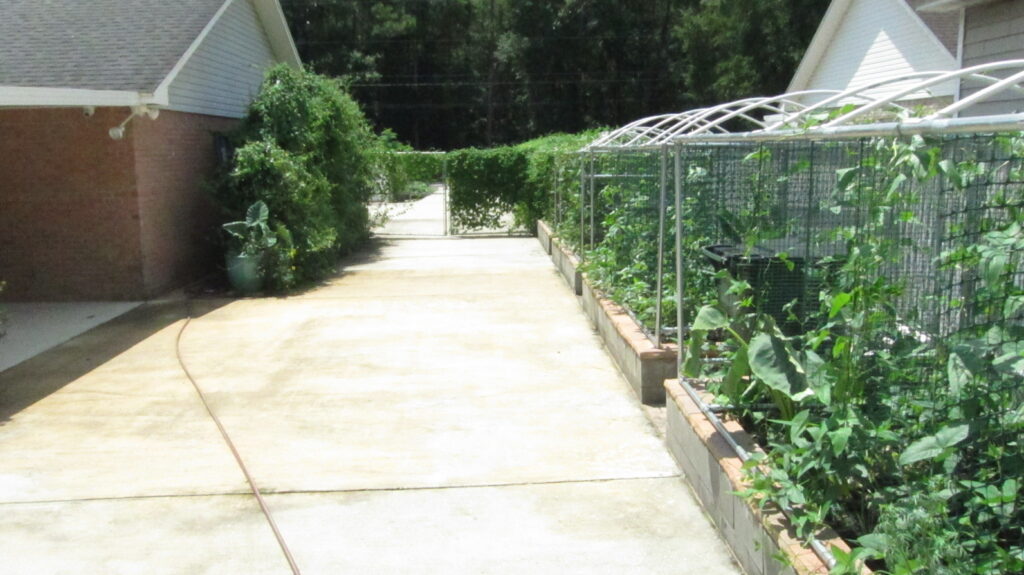
In our experience, the best raised beds are constructed of 8x8x16″ hollow concrete block (each block is packed with sand); these beds are 18″ deep (including 2″ top cap) and have no bottom lining. We’ve had no trouble with moles in these beds. Concrete blocks never rot and can be re-positioned as needed to change the size of the bed (and they can be removed if you get tired of gardening). We’ve built many raised beds with hollow blocks, and we’ve learned a few tricks along the way.

We’ve also tested 8″ raised beds. These short beds are easier and cheaper to construct, and they require less compost. They’re great for sweet potatoes and plants with short roots. Drawbacks include an increased susceptibility to moles, and the need to replenish the compost on a more frequent basis. We’ve also worked with minimally-amended beds; containing 10% compost, they dry out fast and leech nutrients quickly.
A portable raised bed? Yes! Hall’s Hardware sells long galvanized stock tanks that don’t have a bottom. They’re just the right size (about 8′ long x 2′ deep x 21″ tall). If you don’t like the industrial look of the galvanized steel, wrap the tank in bamboo fencing that’s been cut to size. Fill it with compost and you’re good to go. You can construct this raised bed in about an hour.
Read more about EBG’s Raised Garden Beds (including the Bottom Line).
Q: What’s the payback period for our garden?
Counting everything, our garden takes about eight years to pay back the hard cost of the infrastructure (blocks, raised beds, rainwater tank banks, pumps and plumbing, hydroponics, greenhouse, supplies).
Q: Do I need a greenhouse?
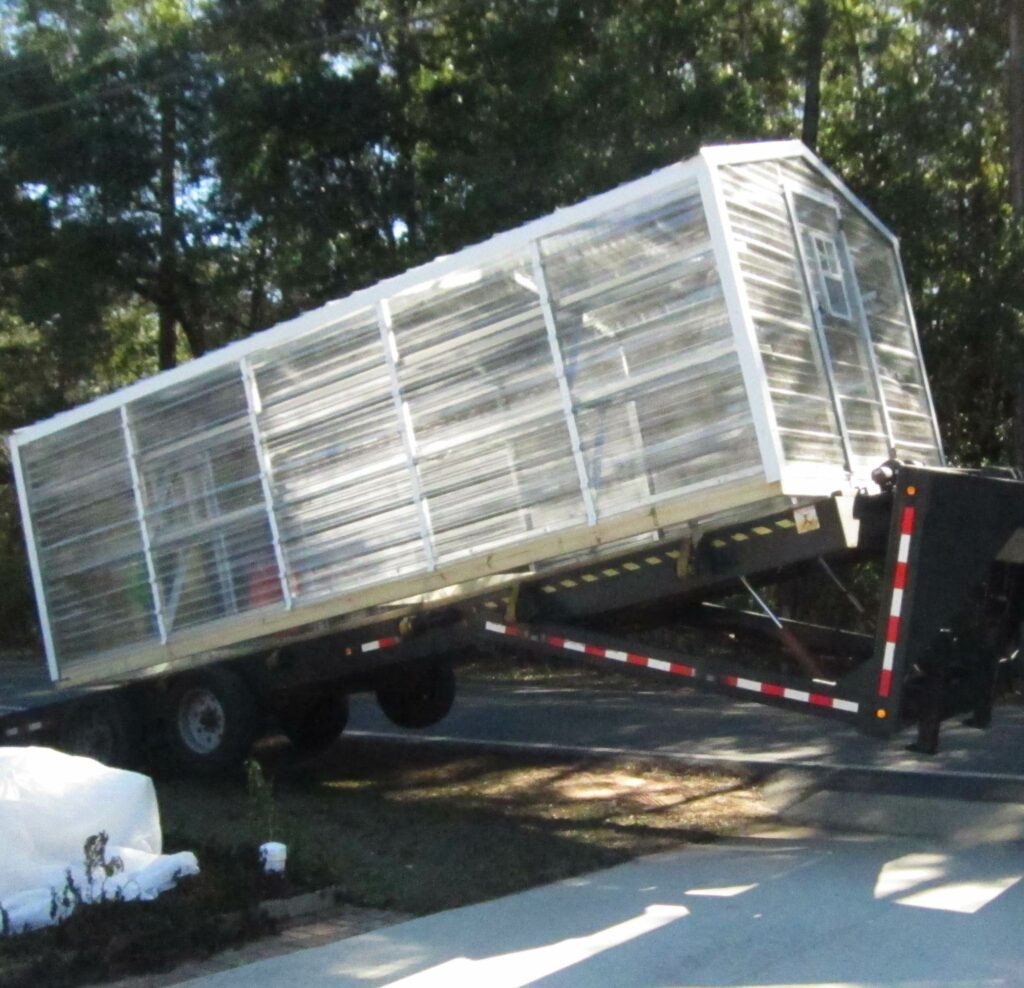
Yes. A greenhouse saves 60-90 days a year by keeping your garden alive through the winter months, and by jump-starting the Spring planting season. Shown here, our 20′ greenhouse arrives in the nick of time.
A greenhouse protects you from losing your most valuable plants. We use it to ensure a constant supply of Moringa Oleifera, and to propagate stocks for early planting.
Read more about EBG’s Steel Framed Greenhouse (including the Bottom Line).
.
.
Q: Is hydroponics practical?
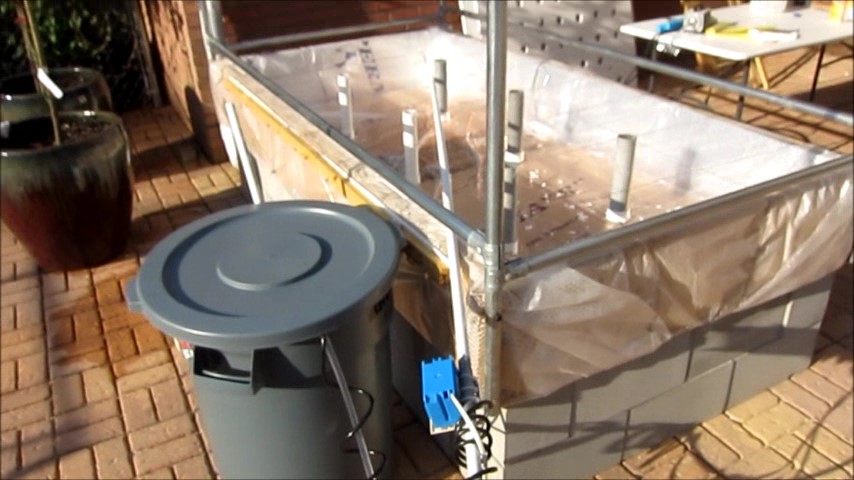
Yes, but only in the Fall and Winter months. Why? Because the summer months are too hot to maintain a constant water temperature in the hydroponic tanks (even with 300 gallons of thermal mass in each tank). This is acceptable because the Spring and Summer months are too busy anyway.
Read more about EBG’s Hydroponic Tanks (including the Bottom Line).
Q: What’s the Tree of Life?

My wife kept telling me about it, but I wasn’t listening. She related childhood memories of using this tree for traditional remedies.
And then I looked it up. Wow! Moringa Oleifera (aka Malunggay, The Miracle Tree, The Never Die Tree) is a verified superfood: tasty, incredibly nutritious, fast growing (one foot per month), all parts edible (the roots are used to purify water), and the bugs won’t touch it! You can top it out and plant the top in the ground to grow another tree! And, it provides full-spectrum nutrition (including more protein than steak). If you only have one plant in the garden, this is the only one you need! What a tree!
Q: What’s a secret sanctuary?
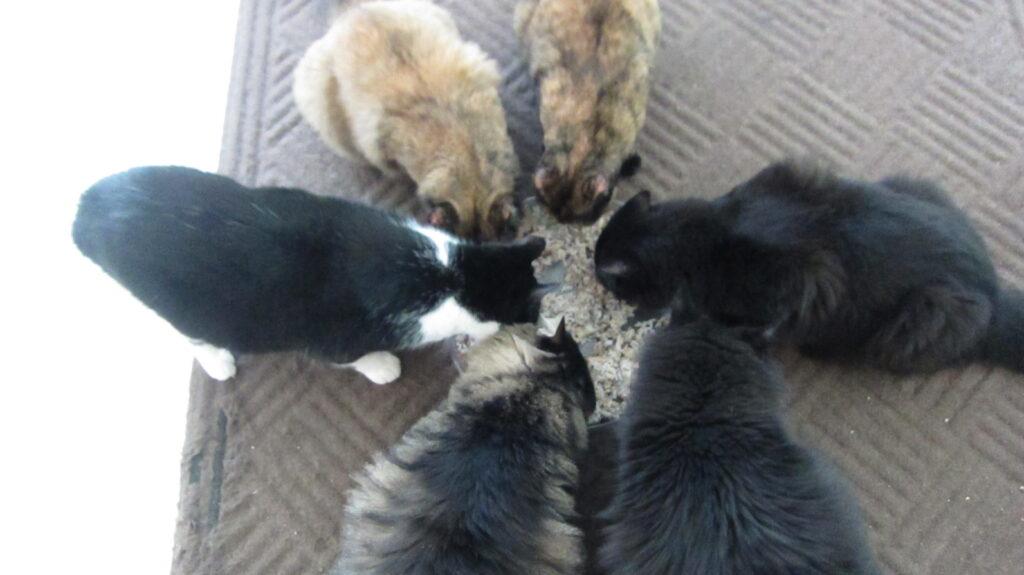
Motivated by a need to care for the abandoned, neglected, and sick pets in the area, secret sanctuaries can be found in almost every neighborhood. That crazy cat person down the street is working hard to handle a problem that most of us overlook or consciously avoid. EBG supports secret sanctuaries, both directly and indirectly. Read more on the Kitty City page. Shown here (starting at the 9-o’clock position) is Tux, Fluffy, Grumpy, Tiny Tim, Stinky Joe, and Scruffy Popadopolous.
Q: Can I cash in on agritourism?
Build it and they will come! At EBG, we host dozens of unscheduled tours each year. From chefs to CEOs, we’ve hosted them all. Like us, hundreds of people are answering the call to return to a self-sufficient lifestyle. Although interested, many people are short on time, have a low frustration threshold, or just don’t know where to start. That’s where we come in. We know what works and what doesn’t and we’re happy to share our experience. There’s not much cash involved, but the connections we make are priceless. After all, our best solutions came from our many friends.
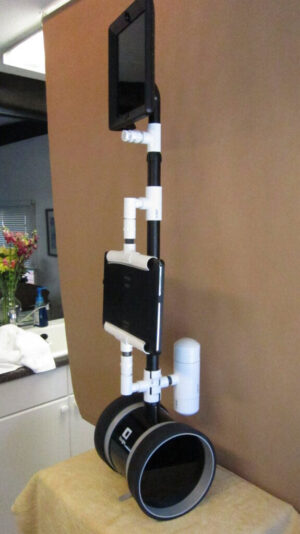
About Dobie (our Double Robot)
Shown here at 6-months old, Dobie has been fitted with a tethered laptop (for roaming), attachment points (for clothing and equipment), a counter-balance (to compensate for breezy conditions), and a locking wallet (for trips to the store).
We poured lots of concrete to make it easy for Dobie (our first-gen Double robot) to “run around” outside. Programmed to conduct tours at EBG, Dobie overheated in the July sun. So, we bought him a hat. That worked for about five minutes and then he overheated again. Then, we bought him a minion outfit to go with the hat (why not?). Unfortunately, Dobie’s navigation is less-than-perfect and he runs into things, so I hacked a game controller and headset to Dobie voice commands. But, Dobie has trouble understanding the soft vowels of the English language (“turn right, stop that, go back”), so I learned to give him commands in Spanish. This worked, but then Dobie “died”. After a short funeral (and photo shoot) we put Dobie in his shipping container and returned him to the factory for resurrection. Several hundred dollars later, Dobie returned (as good as new?). I gave him an audio upgrade and a voice box. A week later, I awoke in the middle of the night to hear him chattering with someone in another country, so I yanked the voice box and went back to bed. To make a long story short, Dobie never fulfilled his mission. He died again and we gave him to a hacker friend. Our memories of Dobie are bittersweet and there are times when we mourn the loss; not for Dobie, but for the hole he left in our wallet.
Q: What does the future hold for EBG?
Here, at EBG, we ask ourselves one question every day: Is the world a better place today than it was yesterday? If the answer is no, we get back to work. If the answer is yes, we go out to eat. I think you’ll agree, the answer (on most days) to that question is a resounding no. Based on all that has come to pass in the last five years, our decision to build EBG has turned out to be a good one. After 45 days without rain (in back-to-back yearly seasons), our decision to extend our rainwater collection system to 7000-gallons has proved to be a good one. After witnessing the recent power outages in other areas of the country, our decision to install solar (in 2015) has proved to be a good one. The list goes on. PS: Every time an oil tanker is attacked, we place an online order for more SPAM. Although reluctant to predict the future, I think it’s pretty clear: the writing is on the wall.
Q: How can I justify a Generac whole-house generator?
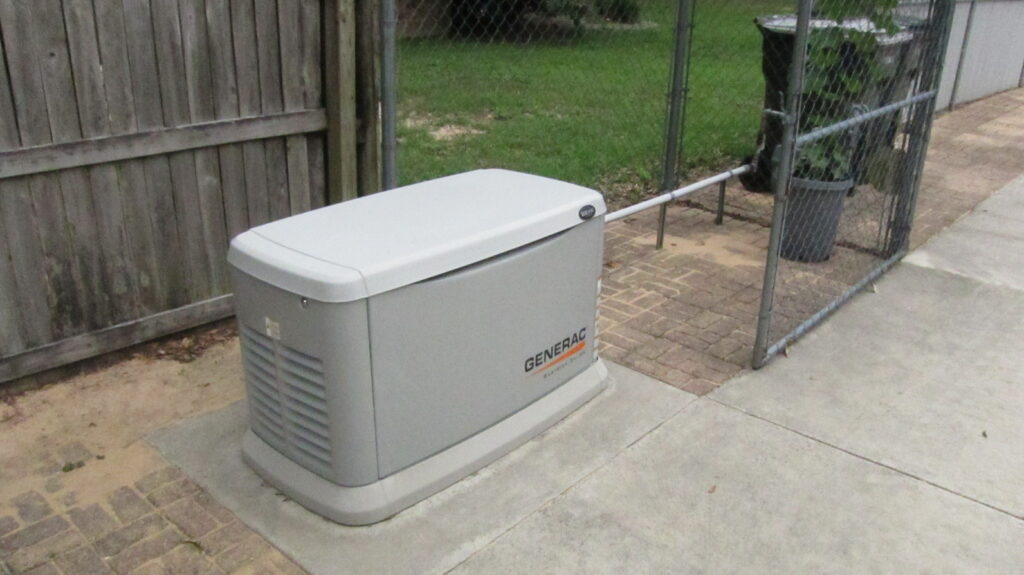
The answer seems to be related to Murphys’ law; if you don‘t have a generator, you’ll surely need one; if you do have a generator, you’ll never need one. Before we installed the Generac, we experienced brownouts on a weekly basis. After we installed the Generac, we rarely experience a brownout. Coincidence? Maybe. Maybe not. So, we installed a storm shelter. If you have a storm shelter, you’ll never get hit by a hurricane. Sounds silly, but this logic seems to work.
What’s the value of electricity when the power grid fails? A Generac is expensive and requires yearly maintenance. You can do the maintenance yourself (easy and cheap) or you can pay someone else to do it for you (expensive but convenient). A Generac is a well-built piece of hardware. Robust and dependable, a Generac will last a lifetime if properly maintained. And, our Generac installer has proved to be very dependable if you have questions or need help. Take it from us. The answer to the initial question is simple: the value of a Generac when the power goes out is incalculable.
Read more about EBG’s Generac Whole House Electric Generator (including the Bottom Line).
Q: What’s the best security solution for a residential property?
A gaggle of geese and a shotgun are ideal (no joke). At EBG, we test a variety of equipment. Our primary security system is ADT. ADT is expensive but their cameras are outstanding, and their wireless cameras are great!. We also use Guardline Wireless Alarms and Sensors. Inexpensive, easy to install and operate, this product has proved to be an excellent addition to our security lineup. We test a variety of other methods as well, but they shall remain secret.
Next up, Chronicles.

